Summer Breeze |
|
 |
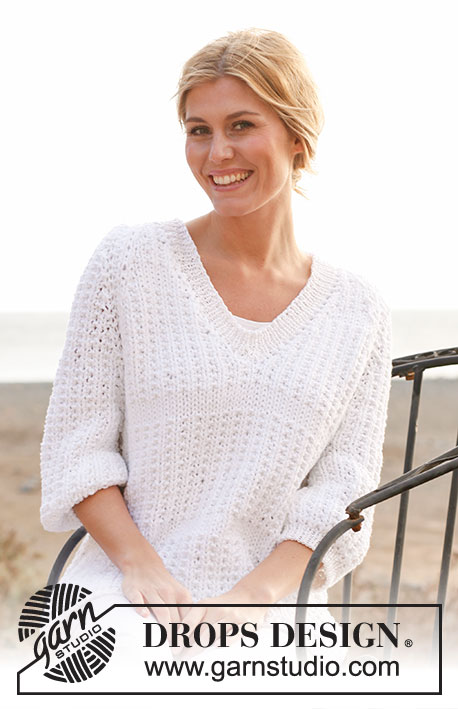 |
Knitted DROPS jumper with raglan in 1 strand “Ice” or 2 strands “Cotton Light” and V-neck and rib in 2 strands “Cotton Viscose”. Size: S - XXXL.
DROPS 136-22 |
|
|
TEXTURED PATTERN BODY: In the round on needle: ROUND 1: K all sts. ROUND 2: * K 1, P 1 *, repeat from *-*. Back and forth on needle: ROW 1 (= RS): K all sts. ROW 2 (= WS): * P 1, K 1 *, repeat from *-*. ** Repeat 1st and 2nd round/row for 15-16-16-17-17-17 cm / 6"-6¼"-6¼"-6¾"-6¾"-6¾", work 4-4-4-4-5-5 cm / 1½"-1½"-1½"-1½"-2"-2" in stockinette st **, repeat from **-** until finished measurements. TEXTURED PATTERN SLEEVE: In the round on needle: ROUND 1: K all sts. ROUND 2: * K 1, P 1 *, repeat from *-*. Back and forth on needle: ROW 1 (= RS): K all sts. ROW 2 (= WS): * P 1, K 1 *, repeat from *-*. Repeat 1st and 2nd round/row until finished measurements. DECREASE TIP 1 (applies to raglan): Work in stockinette st over the middle 4 sts in every raglan transition on every round/row (i.e. 2 sts in stockinette st on each side of all markers). All dec are done from RS! Dec for raglan in every transition between sleeves and body as follows: Before marker: K 2 tog. After marker: Slip 1 st as if to K, K 1, psso. DECREASE TIP 2 (applies to V-neck): Dec for V-neck inside 1 edge st in garter st in each side towards mid front. All dec are done from RS. Dec as follows before 1 edge st in garter st: K 2 tog. Dec as follows after 1 edge st in garter st: Slip 1 st as if to K, K 1, psso. --------------------------------------------------------- BODY: Cast on 184-200-216-240-256-280 sts on circular needle size 3.5 mm / US 4 with 2 strands Cotton Viscose. Work rib = K 1/P 1 for 4 cm / 1½". Switch to circular needle size 8 mm / US 11 and 1 strand Ice or 2 strands Cotton Light. K 1 round while AT THE SAME TIME K2 tog around = 92-100-108-120-128-140 sts. Then work TEXTURED PATTERN BODY - see explanation above. REMEMBER THE GAUGE! When piece measures 41-42-43-44-45-46 cm / 16⅛"-16½"-17"-17¼"-17¾"-18", work next round as follows: bind off 4 sts for armhole, work the next 39-43-47-53-57-63 sts as before (= front piece), bind off 7 sts for armhole, work the next 39-43-47-53-57-63 sts as before (= back piece) and bind off the last 3 sts. Cut the yarn. Insert a marker in the middle st on front and back piece (= 19-21-23-26-28-31 sts on each side of markers). Put piece aside and work the sleeves. RIGHT SLEEVE: Cast on 50-52-54-56-58-60 sts on double pointed needles size 3.5 mm / US 4 with 2 strands Cotton Viscose. Work rib = K 1/P 1 for 4 cm / 1½". Switch to double pointed needles size 8 mm / US 11 and 1 strand Ice or 2 strands Cotton Light. K 1 round while AT THE SAME TIME dec 14-14-16-16-16-16 sts evenly = 36-38-38-40-42-44 sts. Then work TEXTURED PATTERN SLEEVE - see explanation above. When piece measures 18-17-17-16-15-15 cm / 7"-6¾"-6¾"-6¼"-6"-6" (shorter measurements in the larger sizes because of longer sleeve cap and wider shoulders), bind off 7 sts mid under sleeve (i.e bind off the first 4 sts, work following sts as before until 3 sts remain on round, bind off these) = 29-31-31-33-35-37 sts remain on needle. Cut the yarn. Put piece aside and knit another sleeve. LEFT SLEEVE: Work as right sleeve, but when piece measures 18-17-17-16-15-15 cm / 7"-6¾"-6¾"-6¼"-6"-6" bind off the first 3 sts and the 4 last sts on round. YOKE: Slip sleeves on to same circular needle as body where armholes were bind off = 136-148-156-172-184-200 sts. Insert a marker in all transitions between sleeves and body = 4 markers. READ ALL OF THE FOLLOWING SECTION BEFORE CONTINUING! Continue with textured pattern on body and sleeves while AT THE SAME TIME dec for raglan as follows - READ DECREASE TIP 1 - NOTE: The dec on body and sleeves are uneven: SIZE S: ON SLEEVE: Beg on 1st round and dec on every 4th round/row a total of 7 times, then on every other round/row a total of 5 times (= 5 sts remain on sleeve). ON BODY: Work 4 rounds before starting dec, then dec every 10th round/row a total of 4 times. SIZE M: ON SLEEVE: Beg on 1st round and dec on every 4th round/row a total of 7 times, then on every other round/row a total of 6 times (= 5 sts remain on sleeve). ON BODY: Work 4 rounds before starting dec, then dec every 8th round/row a total of 5 times. SIZE L: ON SLEEVE: Work 1 round before starting dec, then dec on every 4th round/row a total of 7 times, then on every other round/row a total of 6 times (= 5 sts remain on sleeve). ON BODY: Work 1 round before starting dec, then dec every 6th round/row a total of 7 times. SIZE XL: ON SLEEVE: Work 1 round before starting dec, then dec on every 4th round/row a total of 7 times, then on every other round/row a total of 7 times (= 5 sts remain on sleeve). ON BODY: Work 1 round before starting dec, then dec on every 6th round/row a total of 4 times, then on every 4th round/row a total of 5 times. SIZE XXL: ON SLEEVE: Beg on 1st round and dec on every 4th round/row a total of 7 times, then on every other round/row a total of 8 times (= 5 sts remain on sleeve). ON BODY: Beg on 1st round and dec on every 4th round/row a total of 11 times. SIZE XXXL: ON SLEEVE: Beg on 1st round and dec on every 4th round/row a total of 7 times, then on every other round/row a total of 9 times (= 5 sts remain on sleeve). ON BODY: Beg on 1st round and dec on every 4th round/row a total of 10 times, then on every other round/row a total of 3 times. AT THE SAME TIME when piece measures 46-48-48-50-50-52 cm / 18"-19"-19"-19¾"-19¾"-20½", bind off the one st with marker on front piece for neck and then work back and forth on circular needle. AT THE SAME TIME dec 1 st in each side towards mid front for V-neck – READ DECREASE TIP 2: Dec on every other row (i.e. on every row from RS) a total of 5 times in all sizes, then on every 4th row a total of 2-2-2-3-3-3 times. After all dec for raglan and V-neck, 57-61-61-63-63-67 sts remain on needle. Continue to work until piece measures 63-65-67-69-71-73 cm / 24¾"-25½"-26⅜"-27⅛"-28"-28¾". Now bind off the middle 13-13-13-15-15-15 sts on back piece for neck (i.e. st with marker and 6-6-6-7-7-7 sts on each side of this), finish each part separately. Continue to bind off 1 st on next row from neck at the back = 21-23-23-23-23-25 sts remain on needle. Slip sts on a stitch holder and repeat on the other side of neck. ASSEMBLY: Sew the openings under the sleeves. NECK EDGE: Pick up approx. 110-114-118-122-126-130 sts around the neck on circular needle size 3.5 mm / US 4 with 2 strands Cotton Viscose. Work rib = K 1/P 1 – adjust so that 1 K st is mid front on V-neck. AT THE SAME TIME dec 2 sts mid front as follows (i.e. at the bottom tip of V-neck): Beg 1 st before middle st, slip 2 sts as if to K tog, pass the first st of the two sts back on left needle, K 2 tog and pass the second slipped st on right needle over. Repeat dec every other round 2 more times. When rib measures 4 cm / 1½", bind off with K over K and P over P. |
|
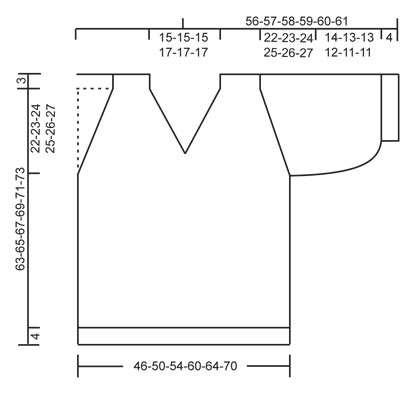
|
|
|
Have you made this or any other of our designs? Tag your pictures in social media with #dropsdesign so we can see them! Do you need help with this pattern?You'll find tutorial videos, a Comments/Questions area and more by visiting the pattern on garnstudio.com. © 1982-2024 DROPS Design A/S. We reserve all rights. This document, including all its sub-sections, has copyrights. Read more about what you can do with our patterns at the bottom of each pattern on our site. |
|







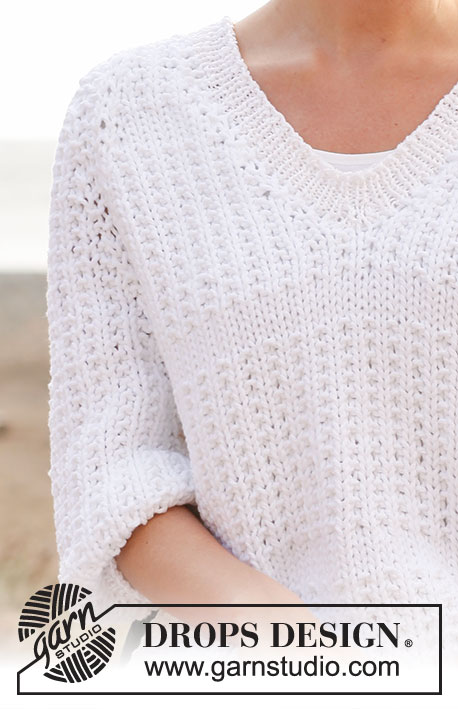

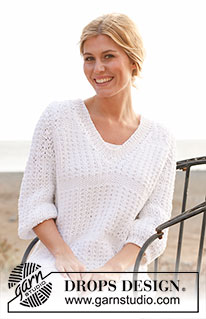
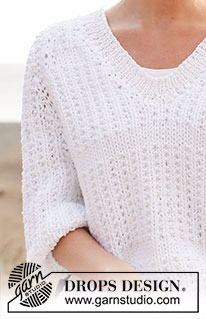
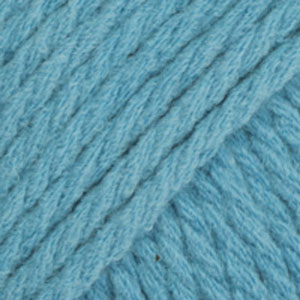



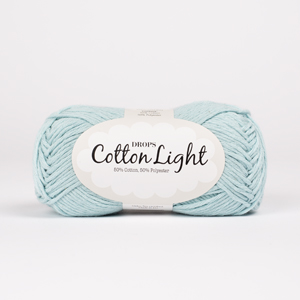


































Comments / Questions (47)
C’est la 2ème fois que je fais ce modèle (TT49) et je n’ai toujours pas compris ce qu’on doit faire des mailles mises sur un arrêt. Pour la taille XXXL c’est 25 mailles de chaque côté. En faisant un assemblage on obtient une pointe au niveau des épaules.
04.02.2023 - 15:50DROPS Design answered:
Bonjour Mme Levêque, lorsque vous avez terminé les diminutions du raglan et celles de l'encolure, il vous reste 25 mailles que vous glissez en attente. Pour tricoter le col, relevez les mailles tout autour de l'encolure en reprenant en même temps les mailles mises en attente à la fin de l'empiècement et tricotez la bordure d'encolure V comme indiqué sur toutes ces mailles. Bon tricot!
06.02.2023 - 15:19Hej vil i hjælpe med en erstatning for cotton viscose to tråde til opskriften summer breeze, kan ikke finde en i jeres omregner. Mvh Marianne
13.08.2022 - 19:06DROPS Design answered:
Hei Marianne. Til denne genseren er det kun brukt DROPS Cotton Viscose i vrangbordkantene. DROPS Cotton Viscose tilhørte garngruppe A, og du kan velge garn fra denne garngruppen. Viscosen i DROPS Cotton Viscose gav en flott glans, denne glansen er dessverre ikke i de andre kvalitetene i garngruppe A. mvh DROPS Design
15.08.2022 - 10:55Bonjour, c'est mon premier top down et je ne comprend pas comment ajouter les manches au dos/devant sur la même aiguille circulaire pour que l'emmanchure corresponde.
11.03.2022 - 12:59DROPS Design answered:
Bonjour Laurence, cette vidéo montre comment vous allez placer les manches sur la même aiguille circulaire que le dos et le devant, entre les mailles du dos et du devant, au niveau des 7 mailles rabattues pour les emmanchures à la fin du bas du pull. Bon tricot!
14.03.2022 - 09:57Peut-on remplacer les 2 fils de viscose par 1 ou 2 fils de cotton Light.
09.02.2022 - 09:10DROPS Design answered:
Bonjour Mme Levêque, pas vraiment car Cotton Viscose faisait partie du groupe A alors que Cotton Light est du groupe B - vous pouvez utiliser DROPS Loves You 7 ou bien Safran . Retrouvez ici comment calculer la nouvelle quantité. Bon tricot!
09.02.2022 - 13:37Ďakujem za pekný model. Plietol sa mi trochu ťažšie, lebo preklad do češtiny bol s mnohými významovými chybami (vďaka anglickej verzii som sa dopátrala, ako to autorky mysleli), tiež mi chýbali niektoré video návody. Trochu tu bol zmätok s vlnou, ktorá sa už nevyrába. Nakoniec sa všetko vyriešilo a z výsledku mám veľkú radosť.
31.07.2021 - 18:29Tusen takk for svar. Jeg må innrømme at jeg er like forvirret på mengden. Hvor mye trenger jeg av Drops Belle og hvor mye trenger jeg av Drops Love you for å strikke en genser i størrelse Large? Blir det: 750 g Drops Belle og Drops Love you, eller 650 g Drops Belle og Drops Love you? Og hva erstatter Drops Viscose? Beklager forvirringen.
22.04.2021 - 12:25DROPS Design answered:
Hei igjen Lene, I oppskriften er det enten Drops Ice eller Drops Light, som er garn fra gruppe B. Drops Belle erstatter her, så du trenger 750 g. Drops Love You erstatter Drops Viscose og her trenger du 150 g. Hilsen Drops Team.
23.04.2021 - 08:26Hei, Hvilke garn skal jeg bruke dersom jeg kun ønsker å bruke plantefiber og ingen oljebaserte fibrer? Hvor mye trenger jeg til størrelse L? Takk for hjelpen! Lene
20.04.2021 - 11:10DROPS Design answered:
Hei Lene, Vi har Drops Belle som er laget av bomull, viskose og lin. Det er et garn i gruppe B, så da trenger du å strikke sammen med et garn fra gruppe A for å få riktig strikkefasthet. Drops Love You er et garn fra gruppe A som er et bomullsgarn. Hvis du bruker disse 2 garntypene, kan du bruke mengdene i oppskriften, men husk å sjekke strikkefastheten din før du begynner. God fornøyelse!
22.04.2021 - 08:22Goedemorgen, de Cotton viscose is uit het assortiment, is er een vervanger? Of zou ik het gewoon van Cotton light kunnen maken en dan 100 steken opzetten met nog 8?\r\nOf hebben jullie een ander idee?
28.03.2021 - 08:16DROPS Design answered:
Dag Helma,
Cotton viscose valt in garengroep A, en kun je dus het beste vervangen door een garen uit garengroep A, zodat je dezelfde dikte hebt. Je komt dan op Safran uit. In plaats van 2 draden uit categorie A, zou je ook voor 1 draad uit Categorie C kunnen kiezen. In dat geval i s Paris een geschikte vervanging.
01.04.2021 - 20:19Als ik bij maat M 61 steken overhoud op het einde van de hals, klopt het dan dat de voorpanden beide 9 steken over hebben? Ik begrijp niet hoe ik dan een ronde hals moet creeren, zonder aan de bovenkant af te kanten op de schouder. De resterende steken van de voorpanden vormen als het ware een hoek van 90 graden (weet niet hoe ik dit moet uitleggen zonder foto), daar kun je toch geen steken bij opnemen zodat het rond wordt? Dank en met vriendelijke groet, Andrea
03.01.2020 - 09:35DROPS Design answered:
Dag Andrea,
Nadat je steken op een hulpdraad hebt gezet voor de hals op het achterpand, kant je nog een keer 1 steek af aan beide kanten. Het is nu inderdaad vrij hoekig, maar als je steken opneemt rondom voor de hals en de halsboord gaat breien, zul je zien dat de 'hoekigheid' erg mee valt en de boord zich wel mooi vormt voor de hals.
08.01.2020 - 09:12J'ai encore une question vous entendez quoi par empiècement car si je tricote tout en aiguilles droites et que je fais les diminution, où vient l'empiècement ? Merci
21.10.2019 - 13:10DROPS Design answered:
Bonjour Fabienne, si vous tricotez tout sur aiguilles droites, vous devez entièrement modifier le modèle pour séparer chaque pièce: dos, devant et manches, du début jusqu'à la fin. L'empiècement se tricotant ici en rond à partir des emmanchures, il vous faudra le diviser également pour le répartir sur chaque partie correspondante. Votre magasin DROPS saura vous aider si vous avez besoin d'aide - même par mail ou téléphone. Bon tricot!
21.10.2019 - 14:53